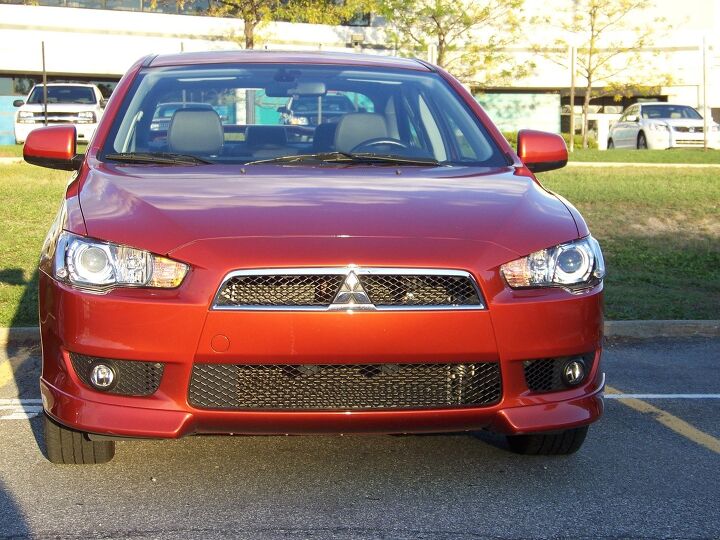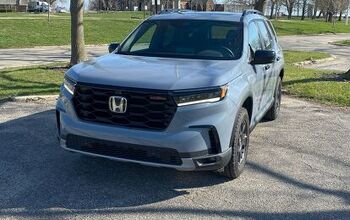Review: 2010 Lancer GTS
I say “Mitsubishi.” You think “Evo.” And not much else, except perhaps, “Are they still around?” The problem: not many people are willing and able to spend BMW money for a Mitsubishi, even if it does offer stellar performance. So Mitsubishi developed the Lancer Ralliart, with a detuned Evo engine, less sophisticated AWD system, and softer suspension. The TTAC conclusion: [url=
The Lancer GTS shares the Ralliart’s and Evo’s convervative, mildly upscale styling, sans Audified grille but mit ricerific wing spoiler and 18-inch multi-spoke alloys. When introduced for the 2008 model year the Lancer was one of the more attractive cars in the segment, with more than a hint of Volvo S40. Today it looks either timeless or mildly dated, take your pick, while staking out the middle ground between the trendy, overstyled Mazda3 and the homely, understyled Subaru Impreza. Select the $150 “rotor glow” orange paint if you desire to attract eyeballs.
The Lancer’s budget-grade interior plastics and switchgear seem much more acceptable (if still behind the curve) when the window sticker is comfortably under $25,000 than when it’s over $35,000. As with the exterior, the cabin’s styling is restrained, with a hint of BMW in the instrument panel’s convex curve from door to door. Optional leather upholstery takes the interior ambiance up a notch, but no one will feel like they’re living large. The new Chevrolet Cruze demonstrates how much more is possible at this price point.
One bonus: the Sun and Sound Package’s 710-watt Rockford Fosgate audio system can rock the neighborhood, though sound clarity at “11” doesn’t seem to have been a top priority. “Punch” the large subwoofer in the trunk up to +6 to shake everything within a 100-yard radius. On the other hand, this package’s keyless access system proved finicky. I never did figure out how to make it work the first time, every time.
The driving position combines the good, the bad, and the ugly. Good: you sit a little lower than in most compact cars, so the Lancer feels sportier and less like the budget compact it is. Bad: the wing spoiler splits the rear view, and is thick enough to largely obscure following cars. (Solution: get the hatchback.) Ugly: the steering wheel (wrapped in overly slick leather) is too far away, and does not telescope. And indifferent: the front seats don’t feel substantial and provide modest lateral support. The rear seat is roomier than most in the segment, but is a little low to the floor.
With the Ralliart’s and Evo’s turbocharged engines kicking out 237 and 291 horsepower, respectively, the GTS’s 168-horsepower 2.4-liter normally aspirated four is clearly third best. But how much power do you need, really, especially when not saddled with the weight of all-wheel-drive? The 2.4 feels much more energetic than the 148-horsepower 2.0-liter in lesser Lancers, and is competitive with the 2.3 in the Mazda3 s and the 2.4 in the Kia Forte EX. There was a time not so long ago that a compact with this much power was considered quick. The 2.4 sounds a little raspy when pushed, almost as if there was a small leak in the intake, but otherwise sings a pleasantly mechanical song. Peak output nearer 200 horsepower might be nice, but as-is the engine’s powerband is usefully broad. Consequently, the five-speed manual’s relatively tall, widely spaced ratios aren’t an issue. Engine speed is about 3,500 at 80, not too bad. The 2.4 is smooth enough that around town I sometimes found myself cruising in third, and could have driven it at 5,000 rpm all day long. Shifting feels like pushing and pulling cables, but it’s easy to find the desired gear and effort is low. It’ll do, but a short throw kit is an obvious mod.
The EPA ratings of 20/28 (improved to 22/31 for 2011) are a little low for the segment. In the real world, I observed from 22 to 28 MPG depending on frequency of stops, and generally averaged 25. A very aggressive drive around a curvy test loop sunk it to 10.1, but this was more a testament to how I was driving the car.
Why bother pushing the Lancer hard enough to nearly sink MPG into the single digits? Because, despite the car’s middling specs and various shortcomings, it’s quite fun to drive. The light steering gets more communicative as it loads up. In hard turns you know exactly what’s going on at the contact patches. The steering is so quick just off center that the car initially felt unstable at highway speeds, but I soon got used to it. There’s a fair amount of roll—some will find the suspension too soft—but no untoward body motions. The Lancer doesn’t feel quite as precise and tied down as the Mazda3, but it’s close. The stability control cuts in a little too early to rein in understeer (which isn’t excessive). The system is unobtrusive—an idiot light is often the only obvious indication that it has intervened—but turning it off permits higher cornering speeds with little risk. The Lancer’s handling remains thoroughly progressive and predictable right up to the limit. The Dunlop SP Sport 5000Ms squeal quietly, so they won’t draw undue attention.
NVH is about average—for 2008. So there’s enough wind and road noise, especially at higher speeds, to make it evident that you’re not in a premium car. The ride is a little thumpy, mostly due to the low profile tires, but isn’t harsh. For maximizing handling short of killing the ride, the tuning is about right.
Ultimately, the Mitsubishi Lancer GTS is more than the sum of its parts. The specs aren’t impressive. The interior and NVH, even less so. And yet it vies with the Mazda3 as the segment’s most enjoyable car to drive. By the end of the week, it felt like a car I’d been driving forever—in a good way. The loaded-up price of $23,000 seems a bit steep, even if it does get you the sunroof, leather, Rockford audio, and various uplevel electronic features. But with generous sales incentives or as a not-much-sought-after used car, and with a 5/60 standard warranty (plus 10/10 on the powertrain for the first owner), the Lancer GTS could be a great buy for the enthusiast on a budget who doesn’t want to drive what everyone else is driving.
Mitsubishi provided the vehicles, insurance and one tank of gas for this review.
Michael Karesh owns and operates TrueDelta, an online source of automotive pricing and reliability data
Michael Karesh lives in West Bloomfield, Michigan, with his wife and three children. In 2003 he received a Ph.D. from the University of Chicago. While in Chicago he worked at the National Opinion Research Center, a leader in the field of survey research. For his doctoral thesis, he spent a year-and-a-half inside an automaker studying how and how well it understood consumers when developing new products. While pursuing the degree he taught consumer behavior and product development at Oakland University. Since 1999, he has contributed auto reviews to Epinions, where he is currently one of two people in charge of the autos section. Since earning the degree he has continued to care for his children (school, gymnastics, tae-kwan-do...) and write reviews for Epinions and, more recently, The Truth About Cars while developing TrueDelta, a vehicle reliability and price comparison site.
More by Michael Karesh
Latest Car Reviews
Read moreLatest Product Reviews
Read moreRecent Comments
- Brian Uchida Laguna Seca, corkscrew, (drying track off in rental car prior to Superbike test session), at speed - turn 9 big Willow Springs racing a motorcycle,- at greater speed (but riding shotgun) - The Carrousel at Sears Point in a 1981 PA9 Osella 2 litre FIA racer with Eddie Lawson at the wheel! (apologies for not being brief!)
- Mister It wasn't helped any by the horrible fuel economy for what it was... something like 22mpg city, iirc.
- Lorenzo I shop for all-season tires that have good wet and dry pavement grip and use them year-round. Nothing works on black ice, and I stopped driving in snow long ago - I'll wait until the streets and highways are plowed, when all-seasons are good enough. After all, I don't live in Canada or deep in the snow zone.
- FormerFF I’m in Atlanta. The summers go on in April and come off in October. I have a Cayman that stays on summer tires year round and gets driven on winter days when the temperature gets above 45 F and it’s dry, which is usually at least once a week.
- Kwik_Shift_Pro4X I've never driven anything that would justify having summer tires.











































Comments
Join the conversation
Great review. I'll acknowledge that I'm biased as I owned (and loved) a 2001 Eclipse GT with the late, velvety 3.0 V6, but I similarly enjoyed test-driving the current Lancer in 2008--the improvement over the flaccid new-for-2002 model was immense. There isn't the depth of talent that you get from a Mazda 3, but the feel and feedback through the controls isn't too far off. If I had to buy a new compact today, it'd be in my top five.
I just totaled my 2010 Lancer GTS Hatchback and I loved it... the NVH was definitely noticeable, especially at highway speeds. I simply cancelled out the sound by cranking up the volume on the "Punch" subwoofer/R.F. sound system... I was considering getting a GTS (non-hatchback this time) again but since the spoiler interferes with the rear-view mirror that much, I'd rather go back to the GTS Sportback. Great review though.